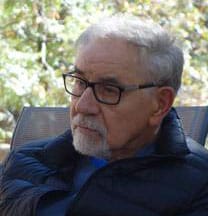 Rodrigo Santos (center)
in a scene from “Sefarad”
Rodrigo Santos (center)
in a scene from “Sefarad” You may not have heard of Artur Carlos de Barros Basto, but when you watch “Sefarad,” a new 90-minute feature produced by the small Jewish community of Porto, Portugal, you’ll understand why he has been called “the Portuguese Dreyfus.” Like Dreyfus, Barros Basto was stripped of his army officer status because of unjust accusations.
“Sefarad’s” opening four-minute scene takes place at the end of the 15th century. Thousands of Jews who were ejected from Castile in 1492 descend on Portugal, including the city of Porto. It’s a colorful medieval cityscape with surprisingly lush production values. Hundreds of extras — merchants, beggars, blacksmiths, rabbis, all dressed in period clothing — interact with one another, speaking in Portuguese and Hebrew.
But danger lurks. The Portuguese king has decreed Jews cannot stay. While Jews gather to pray, mobs, waving crosses, force the Jews to flee Portugal, just as they had left Spain.
The film then takes a 400-year leap to 1923 in Porto, where Barros Basto, then in his mid-30s and an active military officer, is the leader of the Jewish community, which has (again) swelled − this time because Eastern Europeans have converged on Portugal in hopes of continuing west to North or South America. The rest of “Sefarad” focuses on Barros Basto’s triumphs and setbacks as the driving force of the small Porto Jewish community.
In recent days, however, it’s not Barros Basto’s compelling story that has drawn the attention of Jewish press in the U.S. and Israel; it’s the opening four minutes with its large number of extras in period costumes. These four minutes apparently led The Jewish Telegraphic Agency (JTA) to report that “Sefarad” cost more than $1.2 million to make and is “likely the costliest production by any European Jewish community.” Ha≠aretz, the Times of Israel and the Jerusalem Post all echoed JTA in pointing out that this was a huge amount for a small Jewish community to spend on a feature film about its own history.
“There is a lot of romanticism around crypto-Jews and sadly, the story is not the happy fairy tale some people make it out to be.”
— Dara Jeffries
More scathing was JTA quoting an anonymous source — a “former member” of the Porto Jewish community — who said the funds to make the film came from money the community had received for vetting applications for Portuguese citizenship from those who claimed Sephardic/Portuguese roots.
When asked about this, Dara Jeffries, a Porto community member who divides her time between Portugal and Miami, defended the Porto Jewish community’s actions.
“When we were quiet in our corner, nobody bothered us,” Jeffries told the Journal, “but now that we’re visible, people question our motives … . I hate to say this, but people tend to be lashon harah [evil speech; gossipy] … . I have no idea who was JTA’s source. Maybe it’s a former porter who was dismissed or someone like that. The community provides a very important service [by vetting applicants who claim Sephardic roots], and it works with the Ministry of Justice in Portugal, but it’s completely separate from the film, [which was] privately funded.”
Jeffries gave no additional details on the source of funding, but added the Porto Jewish community uses its funds to carry out “an incredibly broad public service mission. It’s opened a museum recently and [“Sefarad”] is shown in the museum. We have thousands of students and visitors every year, and we have an enormous goal in explaining Judaism, the history of Jews in Portugal … . So the film is also for that purpose, to tell people our story.”
It’s quite a story. Barros Basto led the Porto Jewish community from the 1920s until his death in 1961. During the course of the film, we learn he didn’t find out about his Jewish background until he was 17, when his dying grandfather told him about his ancestors. As an adult, he studied with rabbis in Morocco, converted to Judaism, married a Jewish woman and made it his life’s work to give new life to Portugal’s disappeared Jewish community.
“The idea [for the film] was my husband’s,” Jeffries said. “He was a former president of the community.” The community discussed the idea and thought it would be a good idea to make a film.
The screenplay credit doesn’t go to an individual or even several people, but to “The Oporto Jewish Historical Society.” Jeffries conceded there was one person who structured the story and spearheaded most of the drafts. “I don’t think he wants to be particularly known, [and] a lot of it was a group decision.”
In the film, we see Barros Basto on horseback ride out to remote villages, where he finds pockets of crypto-Jews (previously called Marranos and now referred to as anusim), who have carried out secretive versions of Jewish-like rituals for hundreds of years. They are surprised when Barros Basto tells them there are other Jews in the world. Barros Basto is determined to merge these crypto-Jews with Porto’s traditional Jewish community, but some Jews resist his struggle to include them.
“There is a lot of romanticism around crypto-Jews,” Jeffries said, “and sadly, the story is not the happy fairy tale some people make it out to be … . There was a lot of opposition from some quarters, and the Marranos themselves weren’t so keen on it. Initially, [folding them in] seemed like a good idea, but for logistical and religious reasons [it didn’t work out]. Some did convert, many did not, and there are no crypto-Jews left in Portugal as far as I know.”
One of the most dramatic sequences in the film occurs in 1937, when Barros Basto’s military superior receives an anonymous letter accusing the Jewish captain of homosexuality. The charge is dismissed, but the investigation leads to the discovery that Barros Basto has supervised circumcision of crypto-Jewish men. Circumcision is legal in Portugal in 1937, but it is against military regulations for Barros Basto to be involved in it, so he is stripped of his military rank and status.
There is a subsequent scene, where Barros Basto’s accusers are held accountable. His supporters in the Jewish community excommunicate their fellow Jews for having written the anonymous letter accusing Barros Basto of homosexuality, of having committed the sin of lashon harah, which caused him so much harm.
It is ironic that lashon harah, a harmful anonymous comment, is a major plot point in the movie, since it’s also how Jeffries characterized some Jewish media’s reaction to the film.
“Sefarad,” directed by Luis Ismael and written by the Oporto Jewish Historical Society, currently is streaming on Amazon Prime and will be released Dec. 15 on iTunes.





















 More news and opinions than at a Shabbat dinner, right in your inbox.
More news and opinions than at a Shabbat dinner, right in your inbox.